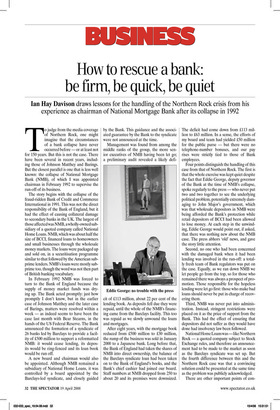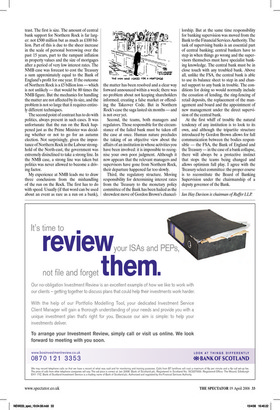How to rescue a bank: be firm, be quick, be quiet
Ian Hay Davison draws lessons for the handling of the Northern Rock crisis from his experience as chairman of National Mortgage Bank after its collapse in 1992 To judge from the media coverage of Northern Rock, one might imagine that the circumstances of a bank collapse have never occurred before — or at least not for 150 years. But this is not the case. There have been several in recent years, including those of Johnson Matthey and Barings. But the closest parallel is one that is less well known: the collapse of National Mortgage Bank (NMB), of which I was appointed chairman in February 1992 to supervise the run-off of its business.
The story begins with the collapse of the fraud-ridden Bank of Credit and Commerce International in 1991. This was not the direct responsibility of the Bank of England, but it had the effect of causing collateral damage to secondary banks in the UK. The largest of those affected was NMB, a wholly-owned subsidiary of a quoted company called National Home Loans. NMB, which was about half the size of BCCI, financed loans to homeowners and small businesses through the wholesale money markets. The loans were packaged up and sold on, in a securitisation programme similar to that followed by the American subprime lenders. NMB’s loans were mostly subprime too, though the word was not then part of British banking vocabulary.
In February 1992 NMB was forced to turn to the Bank of England because the supply of money market funds was drying up. The Bank acted promptly: just how promptly I don’t know, but in the earlier case of Johnson Matthey and the later case of Barings, matters were resolved within a week — as indeed seems to have been the case last month with Bear Stearns, in the hands of the US Federal Reserve. The Bank announced the formation of a syndicate of 26 banks led by Barclays to provide a facility of £500 million to support a reformatted NMB: it would cease lending, its deposits would be ring-fenced and its loan book would be run off.
A new board and chairman would also be appointed. Although NMB remained a subsidiary of National Home Loans, it was controlled by a board appointed by the Barclays-led syndicate, and closely guided by the Bank. This guidance and the associated guarantee by the Bank to the syndicate were not announced at the time.
Management was found from among the middle ranks of the group, the more senior executives of NMB having been let go; a preliminary audit revealed a likely defi cit of £113 million, about 22 per cent of the lending book. As deposits fell due they were repaid, until the whole of the NMB’s financing came from the Barclays facility. This too was repaid as we slowly unwound the loans and mortgages.
After eight years, with the mortgage book reduced from £500 million to £30 million, the rump of the business was sold in January 2000 to a Japanese bank. Long before that, the Bank of England had taken the shares of NMB into direct ownership, the balance of the Barclays syndicate loan had been taken on to the Bank of England’s books, and the Bank’s chief cashier had joined our board. Staff numbers at NMB dropped from 250 to about 20 and its premises were downsized. The deficit had come down from £113 million to £63 million. In a sense, the efforts of my board and team had yielded £50 million for the public purse — but there were no telephone-number bonuses, and our pay rises were strictly tied to those of Bank employees.
Four points distinguish the handling of this case from that of Northern Rock. The first is that the whole exercise was kept quiet despite the fact that Eddie George, deputy governor of the Bank at the time of NMB’s collapse, spoke regularly to the press — who never put two and two together to see the underlying political problem, potentially extremely damaging to John Major’s government, which was that wholesale depositors in NMB were being afforded the Bank’s protection while retail depositors of BCCI had been allowed to lose money. At each step in the unwinding, Eddie George would point out, if asked, that there was nothing new about the NMB case. The press abhors ‘old’ news, and gave the story little attention.
Second, no one who had been concerned with the damaged bank when it had been lending was involved in the run-off: a totally fresh team of Bank regulators was put on the case. Equally, as we ran down NMB we let people go from the top, so for those who remained there was always a prospect of promotion. Those responsible for the hopeless lending were let go first: those who make bad loans should never be put in charge of recovering them.
Third, NMB was never put into administration. Instead, stringent restrictions were placed on it as the price of support from the Bank. This had the effect of ensuring that depositors did not suffer as they would have done had insolvency law been followed.
National Home Loans was — like Northern Rock — a quoted company subject to Stock Exchange rules, and therefore an announcement had to be made to the market as soon as the Barclays syndicate was set up. But the fourth difference between this and the Northern Rock case was that a convincing solution could be presented at the same time as the problem was publicly acknowledged.
There are other important points of con trast. The first is size. The amount of central bank support for Northern Rock is far larger: not £500 million but as much as £100 billion. Part of this is due to the sheer increase in the scale of personal borrowing over the past 15 years, part to the rampant inflation in property values and the size of mortgages after a period of very low interest rates. The NMB case was forecast to cost the Treasury a sum approximately equal to the Bank of England’s profit for one year. If the outcome of Northern Rock is a £5 billion loss — which is not unlikely — that would be 80 times the NMB figure. But the mechanics for handling the matter are not affected by its size, and the problem is not so large that it requires entirely different techniques.
The second point of contrast has to do with politics, always present in such cases. It was unfortunate that the run on the Rock happened just as the Prime Minister was deciding whether or not to go for an autumn election. Not surprisingly, given the importance of Northern Rock in the Labour stronghold of the North-east, the government was extremely disinclined to take a strong line. In the NMB case, a strong line was taken but politics was never allowed to become a driving factor.
My experience at NMB leads me to draw three conclusions from the mishandling of the run on the Rock. The first has to do with speed. Usually (if that word can be used about an event as rare as a run on a bank), the matter has been resolved and a clear way forward announced within a week; there was no problem about not keeping shareholders informed, creating a false market or offending the Takeover Code. But in Northern Rock’s case the saga lasted six months — and is not over yet.
Second, the teams, both managers and regulators. Those responsible for the circumstance of the failed bank must be taken off the case at once. Human nature precludes the taking of an objective view about the affairs of an institution in whose activities you have been involved: it is impossible to recognise your own poor judgment. Although it now appears that the relevant managers and supervisors have gone from Northern Rock, their departure happened far too slowly.
Third, the regulatory structure. Moving responsibility for determining interest rates from the Treasury to the monetary policy committee of the Bank has been hailed as the shrewdest move of Gordon Brown’s chancel lorship. But at the same time responsibility for banking supervision was moved from the Bank to the Financial Services Authority. The task of supervising banks is an essential part of central banking; central bankers have to step in when things go wrong and the supervisors themselves must have specialist banking knowledge. The central bank must be in close touch with any troubled bank. Above all, unlike the FSA, the central bank is able to use its balance sheet to step in and channel support to any bank in trouble. The conditions for doing so would normally include the cessation of lending, the ring-fencing of retail deposits, the replacement of the management and board and the appointment of new management under the direct supervision of the central bank.
At the first whiff of trouble the natural tendency of any institution is to look to its own, and although the tripartite structure introduced by Gordon Brown allows for full communication between the bodies responsible — the FSA, the Bank of England and the Treasury — in the case of a bank collapse, there will always be a protective instinct that stops the teams being changed and allows optimism full play. I agree with the Treasury select committee: the proper course is to reconstitute the Board of Banking Supervision under the chairmanship of a deputy governor of the Bank.



















































































 Previous page
Previous page